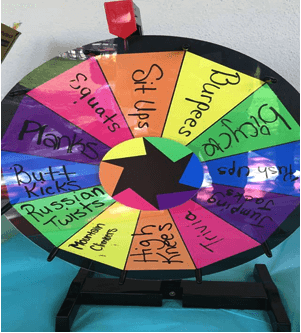8.11: Five Second Fitness
- Page ID
- 14101
\( \newcommand{\vecs}[1]{\overset { \scriptstyle \rightharpoonup} {\mathbf{#1}} } \)
\( \newcommand{\vecd}[1]{\overset{-\!-\!\rightharpoonup}{\vphantom{a}\smash {#1}}} \)
\( \newcommand{\id}{\mathrm{id}}\) \( \newcommand{\Span}{\mathrm{span}}\)
( \newcommand{\kernel}{\mathrm{null}\,}\) \( \newcommand{\range}{\mathrm{range}\,}\)
\( \newcommand{\RealPart}{\mathrm{Re}}\) \( \newcommand{\ImaginaryPart}{\mathrm{Im}}\)
\( \newcommand{\Argument}{\mathrm{Arg}}\) \( \newcommand{\norm}[1]{\| #1 \|}\)
\( \newcommand{\inner}[2]{\langle #1, #2 \rangle}\)
\( \newcommand{\Span}{\mathrm{span}}\)
\( \newcommand{\id}{\mathrm{id}}\)
\( \newcommand{\Span}{\mathrm{span}}\)
\( \newcommand{\kernel}{\mathrm{null}\,}\)
\( \newcommand{\range}{\mathrm{range}\,}\)
\( \newcommand{\RealPart}{\mathrm{Re}}\)
\( \newcommand{\ImaginaryPart}{\mathrm{Im}}\)
\( \newcommand{\Argument}{\mathrm{Arg}}\)
\( \newcommand{\norm}[1]{\| #1 \|}\)
\( \newcommand{\inner}[2]{\langle #1, #2 \rangle}\)
\( \newcommand{\Span}{\mathrm{span}}\) \( \newcommand{\AA}{\unicode[.8,0]{x212B}}\)
\( \newcommand{\vectorA}[1]{\vec{#1}} % arrow\)
\( \newcommand{\vectorAt}[1]{\vec{\text{#1}}} % arrow\)
\( \newcommand{\vectorB}[1]{\overset { \scriptstyle \rightharpoonup} {\mathbf{#1}} } \)
\( \newcommand{\vectorC}[1]{\textbf{#1}} \)
\( \newcommand{\vectorD}[1]{\overrightarrow{#1}} \)
\( \newcommand{\vectorDt}[1]{\overrightarrow{\text{#1}}} \)
\( \newcommand{\vectE}[1]{\overset{-\!-\!\rightharpoonup}{\vphantom{a}\smash{\mathbf {#1}}}} \)
\( \newcommand{\vecs}[1]{\overset { \scriptstyle \rightharpoonup} {\mathbf{#1}} } \)
\( \newcommand{\vecd}[1]{\overset{-\!-\!\rightharpoonup}{\vphantom{a}\smash {#1}}} \)
\(\newcommand{\avec}{\mathbf a}\) \(\newcommand{\bvec}{\mathbf b}\) \(\newcommand{\cvec}{\mathbf c}\) \(\newcommand{\dvec}{\mathbf d}\) \(\newcommand{\dtil}{\widetilde{\mathbf d}}\) \(\newcommand{\evec}{\mathbf e}\) \(\newcommand{\fvec}{\mathbf f}\) \(\newcommand{\nvec}{\mathbf n}\) \(\newcommand{\pvec}{\mathbf p}\) \(\newcommand{\qvec}{\mathbf q}\) \(\newcommand{\svec}{\mathbf s}\) \(\newcommand{\tvec}{\mathbf t}\) \(\newcommand{\uvec}{\mathbf u}\) \(\newcommand{\vvec}{\mathbf v}\) \(\newcommand{\wvec}{\mathbf w}\) \(\newcommand{\xvec}{\mathbf x}\) \(\newcommand{\yvec}{\mathbf y}\) \(\newcommand{\zvec}{\mathbf z}\) \(\newcommand{\rvec}{\mathbf r}\) \(\newcommand{\mvec}{\mathbf m}\) \(\newcommand{\zerovec}{\mathbf 0}\) \(\newcommand{\onevec}{\mathbf 1}\) \(\newcommand{\real}{\mathbb R}\) \(\newcommand{\twovec}[2]{\left[\begin{array}{r}#1 \\ #2 \end{array}\right]}\) \(\newcommand{\ctwovec}[2]{\left[\begin{array}{c}#1 \\ #2 \end{array}\right]}\) \(\newcommand{\threevec}[3]{\left[\begin{array}{r}#1 \\ #2 \\ #3 \end{array}\right]}\) \(\newcommand{\cthreevec}[3]{\left[\begin{array}{c}#1 \\ #2 \\ #3 \end{array}\right]}\) \(\newcommand{\fourvec}[4]{\left[\begin{array}{r}#1 \\ #2 \\ #3 \\ #4 \end{array}\right]}\) \(\newcommand{\cfourvec}[4]{\left[\begin{array}{c}#1 \\ #2 \\ #3 \\ #4 \end{array}\right]}\) \(\newcommand{\fivevec}[5]{\left[\begin{array}{r}#1 \\ #2 \\ #3 \\ #4 \\ #5 \\ \end{array}\right]}\) \(\newcommand{\cfivevec}[5]{\left[\begin{array}{c}#1 \\ #2 \\ #3 \\ #4 \\ #5 \\ \end{array}\right]}\) \(\newcommand{\mattwo}[4]{\left[\begin{array}{rr}#1 \amp #2 \\ #3 \amp #4 \\ \end{array}\right]}\) \(\newcommand{\laspan}[1]{\text{Span}\{#1\}}\) \(\newcommand{\bcal}{\cal B}\) \(\newcommand{\ccal}{\cal C}\) \(\newcommand{\scal}{\cal S}\) \(\newcommand{\wcal}{\cal W}\) \(\newcommand{\ecal}{\cal E}\) \(\newcommand{\coords}[2]{\left\{#1\right\}_{#2}}\) \(\newcommand{\gray}[1]{\color{gray}{#1}}\) \(\newcommand{\lgray}[1]{\color{lightgray}{#1}}\) \(\newcommand{\rank}{\operatorname{rank}}\) \(\newcommand{\row}{\text{Row}}\) \(\newcommand{\col}{\text{Col}}\) \(\renewcommand{\row}{\text{Row}}\) \(\newcommand{\nul}{\text{Nul}}\) \(\newcommand{\var}{\text{Var}}\) \(\newcommand{\corr}{\text{corr}}\) \(\newcommand{\len}[1]{\left|#1\right|}\) \(\newcommand{\bbar}{\overline{\bvec}}\) \(\newcommand{\bhat}{\widehat{\bvec}}\) \(\newcommand{\bperp}{\bvec^\perp}\) \(\newcommand{\xhat}{\widehat{\xvec}}\) \(\newcommand{\vhat}{\widehat{\vvec}}\) \(\newcommand{\uhat}{\widehat{\uvec}}\) \(\newcommand{\what}{\widehat{\wvec}}\) \(\newcommand{\Sighat}{\widehat{\Sigma}}\) \(\newcommand{\lt}{<}\) \(\newcommand{\gt}{>}\) \(\newcommand{\amp}{&}\) \(\definecolor{fillinmathshade}{gray}{0.9}\)Learn:
- Why it is important to build muscles, strength and endurance.
To Give Out: Why Muscle Matters Tip Sheet/ Mini-Water Bottles
Tools:
- Spin wheel with activities
- Signage and handouts
- Yoga Mats/ Mini-Water Bottles
- Whiteboard/chalkboard and chalk/marker, easel (to record scores)
- Timer, stopwatch, or phone to keep time
- Feedback survey, pencils, and collection box
Set-ups:
- Display signage/poster to highlight the goal of your demo, and promotes physical activity demonstration (i.e. key terms, fun facts)
- Set up your score board, the spin wheel with different physical activities.
Activity:
- Have participants spin the wheel and perform the activity.
- Have community leader explain or demonstrate to the participants what safe form looks like.
- Have the participants quickly demonstrate they can do the exercise safely.
- Ask each pair to do the activity for five seconds or more (duration), or for how many times (repetitions) they can in a set amount of time.
- Cue participants during exercise if need to adjust their form, and provide positive feedback
- Have community leaders record the time with a stopwatch (or phone), or count the repetitions, as each participant pair takes their turn.
- Record the times or repetitions for each individual of pair for all to see. Keep this in a leaderboard format, if possible.
- Ask participants to complete feedback survey.
Script:
- Do you know how much exercise you're supposed to get everyday?
- Do you want to try one of our challenges?
- Do you know the difference between strength and endurance?
- Regular exercise can improve your memory, help you sleep, and it can reduce stress, depression and anxiety.

Suggestion for board:
- Key terms
- Exercises to choose from:
- Strength exercise examples: squats, wall-sits, push-ups, plank, lunges
- Cardio exercise examples: hula hooping, jumping rope, jumping jacks
Suggested Information
Key terms
Fitness: Ability to do daily tasks with energy and without getting tired. (HSS,2008).
Exercise: Movement of the body that uses energy that is planned, structured, repetitive, and purposive. (HSS,2008).
Muscle-Strengthening: Exercises that make muscles do more work than usual by holding against an applied force or weight.
Bone-Strengthening: Exercises that produces an impact or tension force on the bones.
Muscular Strength: How much force you can exert (apply) or how much weight you can lift.
Muscular Endurance: How many times or how long you can exert (apply) force without getting too tired.
- As part of your 60 minutes of daily physical activity, be sure to include muscle-strengthening/bone-strengthening physical activity on at least 3 days of the week (HHS, 2008).
- Muscle-strengthening activities are ones that make muscles do more work than usual by holding against an applied force or weight (HHS, 2008).
- Bone-strengthening are activities that produces an impact or tension force on the bones (HHS, 2008).
- Muscular strength and endurance are two important characteristics of your muscles that you have to build.
- Muscular strength is how much force you can exert (apply) or how much weight you can lift.
- Muscular strength endurance is how many times or how long you can exert (apply) force without getting too tired.
Resources:
- U.S. Department of Health and Human Services. (2008). 2008 Physical Activity Guidelines for Americans. Retrieved From: https://health.gov/paguidelines/pdf/paguide.pdf
- TED-Ed. (2017). How your muscular system works - Emma Bryce. Retrieved From: Youtu.be/VVL-8zr2hk4
- TED-Ed. (2015). What makes muscle grow?-Jeffery Siegel. Retrieved From: youtu.be/2tM1LFFxeKg
- Turbulence Training. (2013). 5 at-home exercises you can use to build muscle without equipment. Retrieved From: youtu.be/xCRUFI0XcB0

